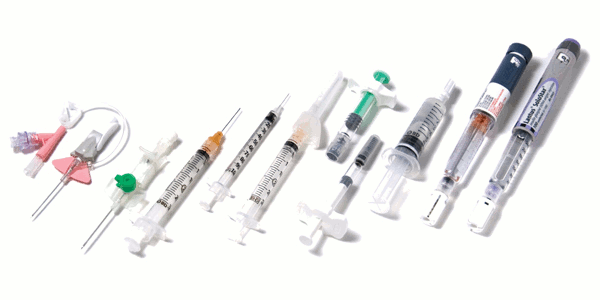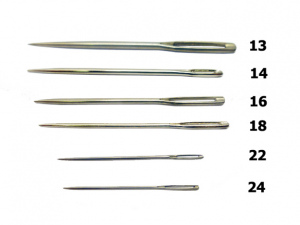Categories
Types of medical needles

Medical needles are mostly used to inject medication into the body of a human being. A needle is any thin and cylindrical object which has a sharp point on its end. A medical needle is hollow and has a hole in the middle to allow the flow of medication into the body of a human being or animal. Medical needles consist of three parts made of stainless steel because of its high resistance to corrosion. The three parts of a needle are the shaft, which is the longest part of the needle, the bevel, which is the slanted tip of the needles, and the hub, which fits firmly onto the tip of the syringe.
Contents
- How does a needle work?
- How do we classify the needles?
- What determines the type of needle to be used by the doctor?
- What are the recommended strange types?
- Types of needles
- Where are they applied?
- How butterfly needles work?
- Where this type of needles is mostly applied?
- What are the specifications of this needle?
How does a needle work?
When a needle penetrates into the body of a human being or animal, the bevel, which is the slanted tip of the needle, creates a narrow hole in the skin of a person to allow the fluid in the syringe to be injected into the person.
Once the needle is withdrawn from the skin of a person, the slit closes to limit the leakage of medication or blood.
How do we classify the needles?
The needles are classified on two factors:
- Length
- Diameter
For the medical needles, the length of the needles ranges from 0.5 inches to 3 inches and the diameter, which is measured in gauges ranges from 7G to 34 G. Here the G means the gauge.
It is essential to note that a gauge of the needle is inversely proportional to the diameter of the needle; the smaller the gauge of the needle the larger the diameter of the needle.
What determines the type of needle to be used by the doctor?
Several factors are considered when choosing the right needle to be used for injection. Among the factors that are considered are:
- The type and viscosity of the fluid; medication
- The body size and age of an individual.
- The mobility status of the patient
- The required absorption rate for the medication
What are the recommended strange types?
For an intramuscular injections (IM), a 21 and 23 gauge needles which are 1 to 1.5 inches long are preferred or recommended for an adult while a 25 to 27 gauge needle which is 1 inch long is recommended for a child.
For the obese patients, a 1.5 to the 2-inch needle is preferred.
For a subcutaneous (SQ) injections, a 25 to 27 gauge needle which is 3/8 to 5/8 inches long is recommended for both children and adults. However, some medications such as Byetta for diabetes recommend the use of a 30 to 31 gauge needle which is 1/3 inch long. These types of needles are chosen because, for one reason, the subcutaneous medications are injected and deposited on the loose connective tissues which are supplied with fewer blood vessels hence low absorption rate of the medication into the blood stream of a person. Another reason is that this layer of tissue consists of many pain receptors which dictate the use of non-irritating, water-soluble medications in small doses.
Types of needles

Depending on the size of the diameter and the gauge, there are various types of medical needles that are used to inject medication into the person’s skin. Some of the medical needles that are commonly used by the doctors are:
- 16 Gauge- this type of gauge is mostly used in the surgery areas. Its larger size allows various procedures to be carried out, such as administration of blood, rapid fluid administration and so forth.
- 18 Gauge- this type of needle can perform many of the tasks that can be performed by the 16 gauge needles, but its large size infiltrates a lot of pain into an individual. Some of the common uses of this type of needle are the rapid pushing of fluids, administering blood, etc.
- 20 Gauge- This type of needle is recommended for patients with small veins. If you cannot push blood with the 18 gauge, 20 gauge will be appropriate.
- 22 gauge– this type of needle is of small size and is appropriate for patients who won’t need an IV long who those who are not critically ill. Because of its small size, it does not allow administering of blood.
- 24 Gauge- this type of needle is mostly used for paediatrics, and it is used as a last resort as an IV in adults.
- Intravenous needle– they are usually inserted into a vein of a person who requires intravenous medication. The needle is attached to an intravenous line that connects the bag of fluids.
- Safety needles- this type of needles are commonly used nowadays in almost all medical setting across the world. The needle is used with syringes that have safety mechanisms where by the needle is covered once the injection is given into the patient. This is used to minimize the risk of the health care worker or patient getting stuck with a contaminated or infected needle.
- Winged Needle-it is also known as a butterfly needle. It is a short, straight and thin hollow needle held by its wings and attached to a slender, flexible catheter line.
Where are they applied?
Butterfly needles are mostly used during the treatment for breast cancer.
The small butterfly needles, (23G) are used on geriatric, pediatric (for the infants/children), patients with “hard or difficult” veins or dermal puncture from the hand of the patient.
The larger butterfly needles (21G) are practically used on patients where the larger amount of blood are required for evaluation or testing.
They are used during the phlebotomy; the collection of the blood sample, and to give a patient intravenous drugs or saline fluids. Since the veins may be fragile and hard to find due to the chemotherapy, it becomes necessary for the use of a very slender needle to access them.
How butterfly needles work?
During the venipuncture operation, the butterfly need is held by folding its “wings” and then at the shallow angle, placed into the vein. A flash is usually seen when the needle is inserted into the vein. (A flash is a small amount of blood that enters the hub of the needle when the needle is inserted into a vein). This assures the phlebotomist that they are in the vein. The phlebotomist can then draw the appropriate amount of blood for diagnostic testing by using the evacuated tube system or syringe.
- Pen Needle- this type of needle comes in variety of needle diameters and lengths. They are used by patients and health professions for injection of various medication. They are mostly used by patients suffering from diabetes and who often require several daily insulin injections.
- Thin Walled needles- They are designed in such away that the inner diameter is large to allow the use of small gauge size with increased rates of flow as compared to regular walled needles. They are designed to efficiently enhance the injection of high-viscosity fluids.
- Hypodermic Needles- These are the needles that are used to inject medications for patient care or treatment. There are various types of Hypodermic needles. Some of which are as follows:
- Biopsy Needle- is a type of needle used to sample biopsy from the cone tumour and also unknown tumour. It can also be used to absorb cells.
Where this type of needles is mostly applied?
Biopsy Needles are mostly applicable to the liver, kidney, thyroid, testicular, breasts, pancreas, skin, uterus, ovaries, and other organs.
- Bone Marrow Biopsy needle- it consists of a handle, needle tubing, protective casing and stylet.
- Thoracic Puncture Needle- is a type of needle usually used for patients who have an effect on puncture exhaust and also drainage of pus for human pleural in clinic
What are the specifications of this needle?
This type of need can be grouped into two groups; type I and type II. The various sizes of this needle are: (18G),(17G),(16G),(15G)
- Disposable & Metal Lumbar Puncture Needle-type of needle very efficient for human body of subarachnoid block to execute a puncture and injection medicine to a patient. Puncturing is efficient for all people across all age group.
- Metal & Disposable Epidural Needle- is a type of needle usually applied to carry out a puncture and injection of medicine for the epidural nerve block of a human body. In this type of needle, puncturing is efficient for all people across all age groups.
- Palate Sinus Puncture needle-this type of needle consist of two parts, needle core and needle tube. The needle tube consists of medical grade stainless steel, and it has a high strength to puncture for the needle tube. This type of needle is designed to for the puncture of the Palatine sinus.
- Stainless Steel Puncture Needle- usually used to bone puncture sampling by clinical institutions across all the age groups. The needle point and length can be easily customized according to the need.
Different types of medical needles are designed in a unique way for various reasons such as injection of medication into the skin of a person and the collection of blood samples for diagnosis purposes. Most medical needles have high strength to prevent bending during the operation and are mostly made of stainless steel hence highly resistance to corrosion.



